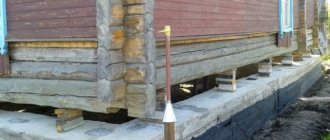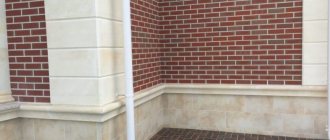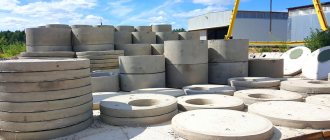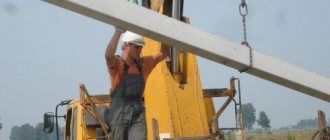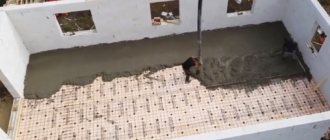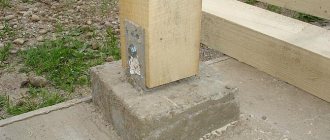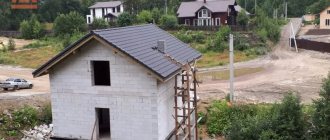The height of the supports depends on the sag of the wire, the distance from the wire to the ground surface, the type of support, etc. The height of the support with horizontal wires on lines without protective cables (Fig. 1) is determined by the following values: 1. The required distance hg of the wire from the ground (dimension for approaching the wire to the ground).
The wires of overhead lines must be suspended at such a height that there is a distance from their lowest points to the surface of the earth that ensures traffic safety. Not only can people pass under the wires, but also cars loaded with bulky objects, tall agricultural machines, cranes, etc. They should not experience an electrical discharge from the line wire.
Rice. 1. Support height
The smallest permissible distances from wires to the ground and some engineering structures are given in table. 1.
Table 1. Dimensions for approaching wires to the ground and engineering structures
The given distances must be maintained under normal operating conditions of the lines. In some cases, for lines with suspended insulators, it is necessary to check the distances resulting from the break of one of the wires.
2. Margin in distance from wire to ground Δ h.
3. Overall sag of the wire f g, at which the distance from the wire to the ground or engineering structure is the smallest.
The overall sag of the wire when determining the height of the support can be at:
1) the highest ambient temperature and the load of the wire only by its own weight, the absence of wind;
2) ice, temperature θ g, lack of wind.
The largest of these arrows is the sag of the wire and is taken when determining the height of the support.
When checking the approach of the wire to the ground and engineering structures in the emergency mode of line operation, a wire break is assumed in the span that in the control span gives the greatest sag of the wire. For example, when an overhead line intersects a communication line with intermediate supports, the break is assumed to have occurred in the span adjacent to the crossing one.
In emergency operating modes of power lines, the permissible distances from the wires to the ground and some engineering structures are set smaller than during normal operating modes of the lines.
The height of the support to the traverse axis will therefore be determined equal to: h 1 = h g + Δh + f g + λ 1 + b
Full height of the support H = h1 + a.
Rice. 3. Height of support with triangular arrangement of wires
When the wires are located, for example, at the vertices of a triangle (Fig. 3), the height h1 of the axis of the lower traverse above the ground is determined in the same way as indicated above. The position of the upper traverse is determined by increasing h 1 by the distance D (adopted between wires of different phases.
The presence of safety cables increases the height of the supports. The required distance is added from the top wire to the cable.
If you liked this article, share a link to it on social networks. This will greatly help the development of our site!
Subscribe to our channel on Telegram!
Just follow the link and connect to the channel.
Don't miss updates, subscribe to our social networks:
Source
Is it possible to use alternative methods for installing power lines on your own?
There are many options for homemade poles with a special foundation at the bottom, with four metal supports, insulators, etc. but they are often used in villages. The most affordable way to quickly and efficiently make a power line support is to install a concrete pole.
The height of the pole, as stated in the electrical installation rules (PUE), should be a minimum of 5 m and a maximum of 12; in practice, 7-meter concrete supports are used. The distance in hard-to-reach places should be at least 2.5 m, in inaccessible places (mountains, cliffs, rocks) - at least 1 m. When crossing non-roadways, on sidewalks, pedestrian paths, the distance can be reduced to 3.5 m. When installing an input panel, its height must be at least 160 cm from the ground.
In villages, the height is often made about 4 m so that a truck can easily pass, and since the PUE does not set any restrictions on the design, all available materials, homemade metal trusses, beams are used, which is highly not recommended.
To install a concrete support you will need:
This team is able to reliably install a support for many decades in a matter of hours, and guarantee us an uninterrupted supply of current for many years.
Source
The height of the electric pole from the ground: how to install it correctly on your site
If you find yourself in a situation where the issue of electrifying your suburban area is being decided, then you are probably faced with the question of how tall the electric pole should be. Many people don’t know whether they have to install it themselves, or whether it’s the work of electrical networks, and what material is best to install the pole from.
The topic is quite rare and practically not covered on the Internet. Apart from specialized sites and SNiP, which not everyone can navigate.
Requirements for installation of electric poles
If you need to install an additional power pole to connect your home, you must first contact the organization responsible for the energy supply of the locality.
For this you will need documents:
The list of documents depends on the region. It's best to call your local power company and find out exactly what you need.
If everything is in order with the documents, a positive decision will be issued. The applicant will receive technical conditions and two copies of the contract for connection to the electrical network, signed by authorized persons of the company, in writing or in hand. You will need to sign contracts and return one of them.
The received agreement will specify the period for connecting the site to the electrical network. Usually this is six months.
If the power line runs close to the house, then you can speed up the process by coordinating your actions with the power grid and installing the pole yourself.
More often, electrical networks recommend contacting specialized organizations or offer a quick solution for a fee. You need to act in such a situation in such a way as to protect yourself from mistakes.
If you decide to connect to the network faster, then you will have to spend money on the pole itself, its transportation, renting a crane and drilling rig, and paying for the work of the installation team.
It must be taken into account that the pillar will be buried to a depth of 1.5-2 meters for stability.
Height of a concrete electric pole from the ground
The technical specifications will specify the distance between the supports and their recommended height. This data will greatly simplify the task, so all that remains is to complete the installation part of the work.
An additional post can be made of different materials. Each has its own advantages, disadvantages and technical characteristics.
Installation of electric concrete pole
Reinforced concrete power transmission poles are manufactured in industrial conditions. Their code designation is SV (vibrating racks).
Inside the structure there is a metal frame that strengthens the concrete.
Advantages of concrete supports:
The main disadvantage of a reinforced concrete pillar is its large mass, which makes transportation more difficult. Only trained specialists can install it.
During transportation, there is a high probability of cracks and chips appearing on the material. Installation involves the use of heavy equipment in the form of a crane and a drilling rig.
In addition to the code abbreviation “SV”, the marking of such products contains numbers (95, 110, and so on), indicating the length of the support in decimeters. Each type has its own characteristic method of reinforcement, which allows achieving optimal strength indicators.
More detailed information is in the text of GOST 23009-78.
There are 4 standard sizes of reinforced concrete pillars: 9.5; 10.5; eleven; 16.4 meters . The height of the electric pole from the ground will depend on the depth of the product's immersion in the ground. The average value is 7 meters.
Metal pillars and their height
GOST 9.307-89 defines all the requirements for the manufacture of metal supports for power lines. All such pillars are hollow, so their weight compared to concrete supports seems insignificant.
Products are protected from corrosion by hot-dip galvanizing. Coating thickness – 60-120 microns. The indicator is small, but this is enough to ensure the service life of supports in temperate climates for up to 20-25 years.
On the coast, such a pillar will rust within 5-7 years due to excess salt content in the atmosphere and precipitation.
Metal poles with electrical input panels
Convenience of metal poles in simplified installation technology.
This support consists of two parts:
There is no need to dig the soil 2 meters deep. Stability is ensured due to the large support area and the mass of the reinforced concrete base. It weighs many times more than the pillar itself and physically cannot tip over.
The trunk is cone-shaped, rectangular or round. To hang the necessary equipment, brackets are attached to it.
More often, metal poles are used where electrical cables are laid in the ground. For example, as lighting poles on city streets and illuminated sections of highways. The hollow structure allows the cable to be pulled inside, providing it with reliable protection from external influences.
Metal poles are also used in home areas for lighting. There are models of different types and shapes.
Manufacturers most often use primer, powder or hammer paint as a protective coating.
Advantages of metal supports:
There are no disadvantages, except for the electrical conductivity of the design, which requires high quality protective insulation for cables and individual wires.
The height of metal supports depends on their type and purpose of use. The minimum norm is one and a half meters.
Height of wooden electric pole
Wooden poles have somewhat lost their relevance. You can meet them either in small settlements or within dacha cooperatives.
A wooden support is a rounded log of a certain length and diameter. These supports are used where it is necessary to quickly and inexpensively solve the issues of electrification of a site.
They have standardized dimensions. Enterprises produce them in 5 versions: 6.5; 7.5; 9.5 and 11 meters. The trunk diameter is 14-24 cm. Products are light, medium and heavy.
Wooden poles require periodic treatment with protective compounds so that their service life is not reduced due to exposure to humidity and ultraviolet radiation. Most often they are burned or impregnated with oils and mastics.
In the manufacture of such poles, inexpensive wood species that are resistant to high humidity are used. Pine fully possesses these characteristics.
Requirements for power lines up to 0.4 kV in populated areas
Voltage 0.4 kV is the maximum for input into a private house. For such lines within cities and SNT, requirements have been developed for the distance from supports to utility facilities.
Diagram indicating the distances from supports to residential buildings
The distance between the line posts is no more than 50 meters. It depends on the wind and snow load in the installation region. All calculations are made by specialists. The distances they recommend should not be exceeded.
The maximum distance from the main support to the wall of the house is 25 meters. Otherwise, you will need to install additional supports.
The distance from the main to the additional distribution pole is not clearly standardized. Its location must be determined by analyzing the site plan, points of entry of electrical lines into the house and installation locations of the main supports.
The distance from the additional distribution support to the wall of the house should be no more than 10 m and no less than 2 m. From the fence to the support should be at least 1 m, which is enough to provide space for electricians if it is necessary to carry out work on the pole.
The support is not prohibited from being located on the inside of the site. However, it is necessary to ensure unimpeded access to it for energy services.
The minimum standard height for cable entry from the power line into the house is 2.75 m.
Requirements for a summer cottage
The PUE does not divide buildings into urban and suburban and imposes the same requirements on all objects, since the location of the property does not in any way affect fire safety.
The only difference is the procedure for processing documents for electrification of a site.
Trained teams must install power line poles in SNT
The electric grid facilities of SNT, ONT or DNT are public property. There are no representative offices of energy companies on their territory. Therefore, a standard connection agreement is concluded between the partnerships and the network company.
In other words, the issue of electrification will have to be resolved not directly, but through the chairman of the partnership. All members of the partnership, as well as persons living with them, have the right to join the networks.
The agreement between SNT and the network company stipulates the maximum power allocated to gardening. This means that if, when connecting a new garden house to electrical networks, this limit is not exceeded, the partnership will not have to coordinate the connection and renew the contract.
A member of the partnership must write a statement addressed to the chairman. Acceptance of this document and the right to connect to electrical networks cannot be denied.
After connection, electricity is paid to the responsible person from SNT, who pays the network company according to the installed meter.
debarking
The bark and phloem are removed using a specialized machine. Only after this the trunk begins to dry. Sapwood should be touched to a minimum, since it is this wood that is well saturated with an antiseptic. If the entire top layer is cut off, the durability of the support will be greatly reduced due to the fact that it will be more susceptible to rotting. Then the wooden support, the dimensions of which meet the requirements, is sorted according to its intended purpose. Some manufacturers dry the wood without removing the bast, which makes it possible to prevent cracking of the wood. Then the bast is removed, as it will interfere with the impregnation process.
Designation of supports
For metal and reinforced concrete supports of 35-330 kV overhead lines in the CIS, a conventional designation system has been adopted.
| Letters | What do they mean? |
| P, PS | intermediate supports |
| PVS | intermediate supports with internal braces |
| PU, PUS | intermediate corner |
| PP | intermediate transitional |
| AU, U, US | anchor-corner |
| A | anchor |
| K, KS | end |
| B | reinforced concrete (does not apply to 500 kV supports) |
| M | Multifaceted |
| Absence of B | steel |
| PC | Intermediate composite |
The numbers after the letters indicate the voltage class. The presence of the letter “t” indicates a cable stand with two cables, the letter “p” indicates a change in the relative position of the wires on the support (usually involves moving the wires of the upper or lower tier to the middle tier). The number separated by a hyphen indicates the number of circuits: odd - single-circuit line, even - two and multi-chain, or type of support. The number separated by “+” means the height of the attachment to the base support (applicable to metal supports). The designation system corresponds to the design documentation of the manufacturing plants and may differ from the conventionally accepted form.
1U110-4P
Details Category: Double-circuit anchor-angle steel poles 110 kV
| product name | 1U110-4P | 1U110-4P+5 | 1U110-4P+10 | 1U110-4P+15 |
| Ice area | I-IV | I-IV | I-IV | I-IV |
| Wind district | III | III | III | III |
| Wire brand | AS-240 | AS-240 | AS-240 | AS-240 |
| Dimension in foundation axes L, m | 4,08 | 5,33 | 6,58 | 7,83 |
| Support height N, m | 22,6 | 27,6 | 32,6 | 37,6 |
| Height to lower traverse h, m | 8,6 | 13,6 | 18,6 | 23,6 |
| Weight of support with zinc, kg | 5981 | 7963 | 9671 | 12193 |
| Model project number | 3.407.2-166 | |||
| Note | Support for hanging wires in two tiers at intersections. Spacers may be used in these supports (the weight is not taken into account). Lightning rods for the supports are supplied as a separate order. |
Characteristics of reinforced concrete transmission line racks
⇒Reinforced concrete pillars are made of different brands and are designated in this way, for example, concrete post SV 95-2, where 95 is the length of the post in decimeters, and 2 is the conditional load-bearing capacity.
According to GOST 23009-78, racks are manufactured in the following standard sizes:
They also differ in the method of reinforcement, on which the load-bearing capacity depends.
Power transmission line support racks SV 95
Reinforced concrete poles SV 95 are widely used for laying and installing networks with a voltage of 0.4 kV and for laying communication lines. They are mainly used for connecting summer residents to electrical networks when installing an additional power pole. For their manufacture, heavy concrete (class B30) is used, which complies with GOST 26633-91 standards. As a filler for this concrete, manufacturers use granite crushed stone with a strength index of at least M 1200 - M 1400, frost resistance F 300.
The SV-95 reinforced concrete pole at the manufacturing enterprise is supplied with embedded iron products intended for connecting structures and grounding parts.
Racks SV 110
Reinforced concrete racks SV 110 are designed for power lines with voltages up to 10 kV.
They can also be installed for communication lines. Reinforced concrete poles SV 110 are resistant to aggressive environments, low and high temperatures and can be successfully installed in areas with a high degree of fire danger. Reinforced concrete poles SV 110 also find their use as lighting supports. Their production is carried out using heavy concrete using the vibrocompression method. These concrete mixtures have a compressive strength class of B30.
The length of the SV 110-3.5 and SV 110-5 stands is 11 meters. At the base of the support the height is 280 mm, and at the top the height is 165 mm. The width of the base is 170 mm, the top is 175 mm. The weight of the concrete support is 1150 kg. The SV 110-3.5 posts have a design bending moment of 35 kNm, and the SV 110-5 posts have a design bending moment of 50 kNm.
Reinforced concrete supports SV 110 are made of heavy concrete with the following characteristics:
Each of them is equipped with embedded metal products designed to secure structures and connect parts of the grounding structure and are manufactured in strict accordance with GOST and TU standards.
Source
Features and advantages of reinforced concrete power transmission line structures
Reinforced concrete pillars are considered the most common and reliable option. They are characterized by:
- high strength parameters;
- durability (50 or more years of reliable operation);
- corrosion resistance;
- fire safety;
- resistance to aggressive environments, moisture, low temperatures.
Manufacturers produce poles of various sections and sizes, which vary depending on the purpose of the supporting product and the loads placed on it (ice and wind). According to the design solution, products are divided into single-post or portal versions, free-standing or guyed. Single-post products are aimed at installing street lighting. Concrete electric poles having an anchor-corner design with guy wires are used for high-voltage networks.
If we look at the product labeling, the letter designations suggest that:
- products with the abbreviation SV are vibration racks made from prestressed or non-stressed building material;
- SK – conical, annular section;
- SC are cylindrical, which are produced from heavy types of concrete by centrifugation.
The value of the first digit reflects the length of the product, indicated in decimeters. The second numerical designation of the marking indicates the load-bearing capacity of the beam (during bending testing).
The strength characteristics of concrete poles for electrical networks are ensured by the use in their production of concrete mixtures of classes B30, B 40 and B45, granite crushed stone as a filler and high-strength steel reinforcement.
Regulatory requirements for the installation of electricity poles
Standards for additional electric power transmission poles are regulated at the legislative level. The requirements are as follows:
Before installing the pole, you should understand the classification. There are four types:
In addition to standard types of poles, there are specialized ones. This is a generalized name for pillars of non-standard configuration. They are used at intersections of power lines with railways, highways, buildings and structures. Such structures are not used in summer cottages.
General requirements for power lines with voltage up to 1 kV
When installing power transmission line supports on private land, technical requirements must be observed. To check compliance, you must be guided by Article 2.4 of the Electrical Installation Rules, with operating voltages up to 1 kV. The list of standards is as follows:
IMPORTANT! Before sending an application for approval and connection of power lines, you need to make sure that the requirements are met. Otherwise, the application will be rejected and the process will be delayed.
Flaws
Along with the advantages, wooden supports have disadvantages.
- Impregnating compositions may contain harmful substances that are in the air of the work area (fuel oil, kerosene, creosote, etc.). Oil-based antiseptics are especially harmful. In addition, they have an increased fire hazard.
- Logs must be manufactured with the required diameters and taper.
- High-quality products are obtained by winter cutting and drying under a canopy for 6 months. Here it is necessary to treat the logs with an antiseptic so that they do not rot.
Stages of work on installing supports
The procedure for installing electricity poles and connecting them is as follows:
After installation and quality control of the line, the house and other buildings on the site are electrified.
Material
All types of supports can be made from the following materials:
The choice should be made between wooden and reinforced concrete pillars. Metal structures are designed for heavy loads. They are used at substations with capacities up to 110 kV. The use of such power lines in a summer cottage is inappropriate.
Concrete structures are stronger than wood, but they are more expensive. It is possible to use a combined option: a main wooden pole is attached to a reinforced concrete support. This method allows us to achieve an optimal balance of strength and durability with manufacturing cost.
Planning
After choosing the type of supports to use, you can begin to draw up a plan for the location of power lines. To do this, you need to contact an electrician. Such services are provided by energy sales organizations.
At the stage of drawing up a location plan, approval of the installation is carried out immediately. To clarify the cost of the service, the owner should contact the organization that provides access to electricity in the area where the site is located.
Land preparation
Preparatory procedures include clearing the area of the site from debris, plants and roots. A hole for supports is being drilled.
IMPORTANT! The depth of the supports should be greater than the freezing depth of the ground. An expansion must be made at the bottom of the pit. This is required to avoid the support being pushed out during the winter months.
Installation of supports
Once the installation site is ready, the poles are installed. The structure is fixed with concrete. During the pouring process, it is necessary to ensure compliance with the dimensions, in particular, the vertical position of the support.
ADVICE! Before pouring the concrete solution, it is recommended to cover the pit walls with waterproofing material. This will increase the service life of the pillars, due to the isolation of the structure from the influence of groundwater.
Installation of wiring in the house
After preparing and installing the pole on the site, it is necessary to address the issue of connecting electricity to a private house. This can be done both from the supply support, if it is located on the site, and through an intermediate pole. The following methods are used to connect them:
- bare aluminum wire;
- copper or aluminum cable;
- SIP (self-supporting insulated wire).
Cables can be laid from an intermediate or supply pole to the house not only by air, but also underground. This method is used much less frequently than steel cables stretched through the air.
The condition of power lines is significantly influenced by the type of supports used. For 100 years, the wooden support remained one of the main structures of overhead lines (OL).
Only in the 60s of the last century they began to make it with protective impregnation. At that time, instructions were given on the use of antiseptics, but they were poorly implemented, which led to rotting of the supports. The widespread transition to reinforced concrete pillars did not solve all the problems, since they showed disadvantages that are not inherent in wood products:
- fragility upon impact;
- low bending strength;
- significant weight;
- presence of leakage currents.
